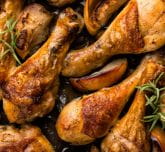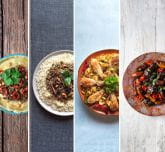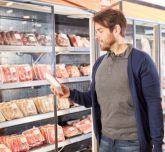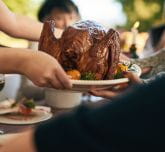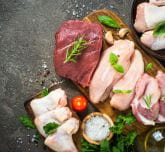The worldwide poultry and game market
Highly appreciated all over the world for its taste and its affordability in comparison with other meats, poultry consumption is rising. In parallel, its production has shot up in recent years: +55% in the past 15 years and +13% between 2011 and 2017 alone.
In total, world production stands at about 122 million tonnes, of which 11% is exported. Poultry represents 21% of worldwide trade in meat, making it the second most-exported meat in the world. Top of exporting countries are Brazil, the United States, Poland and the Netherlands.
Today, poultry alone accounts for 35% of the meat consumed in the world, just behind pork. An average of 13 kg is eaten per year and per inhabitant, and this should continue to rise: according to projections by the FAO and the OECD, poultry production should continue to rise by 1.24% annually in the world between 2017 and 2026, mainly in the least developed countries (+2.48% forecasted).
With more than 20 kg consumed each year per person, Europe is one of the regions in the world which appreciates this type of meat the most. Unsurprisingly, chicken is top of the poultry list in the European Union (EU) accounting for 83% of total consumption in the zone. Next on the list are turkey (13%), duck (3%) and other poultry meats (cockerel, poussin, guinea fowl, etc.) which make up the remaining 1%. The British are the leading poultry consumers, with an average of 28 kg per capita per year, followed by the French (28 kg) and the Germans (21 kg).
In the rest of the world, it is the USA that eats the most poultry, with overall consumption of 16.2 million tonnes of chicken in 2018, according to data from the United States Department of Agriculture (USDA). China arrives in second place with 11.6 million tonnes consumed, followed by the EU (11.5 million tonnes), Brazil (9.7 million tonnes), India (4.85 million tonnes), Russia (4.8 million tonnes), Mexico (4.3 million tonnes), and Japan (2.8 million tonnes), also according to USDA figures.
Meanwhile, game meat is much less widespread. While it used to be eaten a lot many years ago, it has gradually been replaced by meat from farmed livestock. Today, wild and raised game has become a more occasional dish in developed countries. It is, however, beginning to make a comeback, with new-found popularity in countries such as Japan.
Poultry and game in France
Poultry consumption
The French are very keen on poultry: they consume the equivalent of 28.5 kg per year per person. This is twice the worldwide average and slightly above the European average.
Here again, chicken stands head and wings above the rest, with 19.5 kg (out of the 28.5 kg in total) consumed per person each year. Turkey arrives in second position in household poultry preferences, plucking up 4.5 kg per year and per inhabitant. In third place comes duck, with an annual average of 2.9 kg per person.
France is also a leading producer of poultry. In the EU, it is the biggest producer of guinea fowl, the second largest producer of poultry and turkey, behind Germany, and the fourth largest chicken producer, after Poland, the United Kingdom and Germany. On a worldwide scale, France is also the third largest producer of turkeys.
Consumption of game
Whether it be ground game (venison, wild boar or bison), feathered game (pheasant, mallard duck, partridge, wood pigeon, quail and starling) or small game (hare and rabbit), French consumption in this category is much lower than that of poultry.
Overall, 15,000 tonnes of game meat are consumed each year, representing approximately 600 g per year and per person. These meats are therefore consumed in exceptional circumstances, in particular around Christmas and New Year.
The majority (between 70 and 80%) is imported from countries such as Australia and regions such as South America and central Europe. Only 50% of wild boar is imported.
The “poultry and game” segment at SIAL
From chicken and turkey to duck and cockerel, and from rabbit to game, the “poultry and game” segment is perfectly represented at SIAL Paris with, at the 2022 edition, no fewer than 142 exhibitors. The vast majority of these (85%) come from outside France and attend SIAL to promote their products to a wide audience.
With a clear focus on innovation, SIAL also allows professionals from the industry to discover the latest new products through SIAL Innovation, which selects the most innovative products according to various criteria.
Your dedicated sales representative

Other sectors presented at SIAL
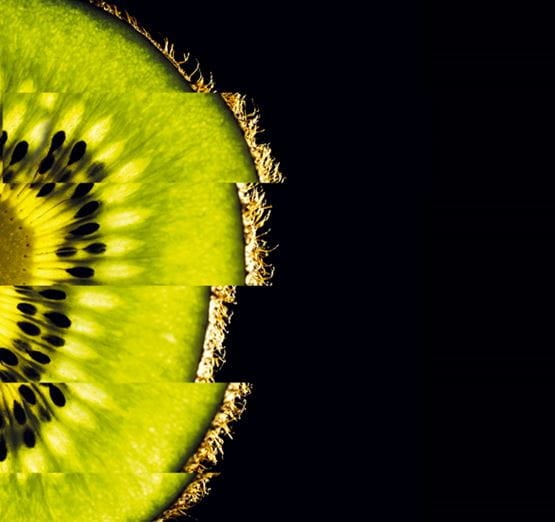
INSPIRING FOOD BUSINESS WORLWIDE
- Food & Drinks Malaysia - Kuala Lumpur
- SIAL Canada - Montreal
- SIAL Canada - Toronto
- SIAL Paris - Paris
- SIAL in China - Shanghai
- SIAL in China - Shenzhen
- SIAL in India - New Delhi
- SIAL Interfood - Jakarta
- Gourmet Selection - Paris
- Cheese & Dairy products show - Paris
- Djazagro - Algiers


